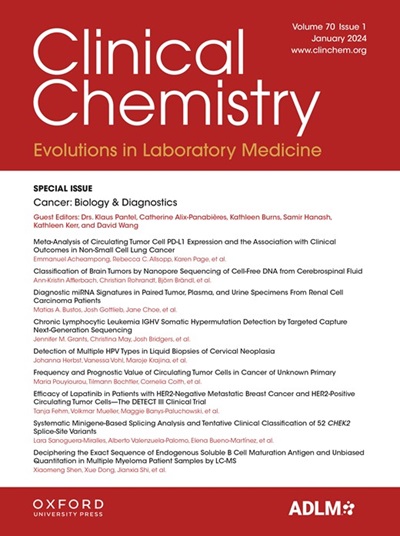A-171 Novel Fluorometric Assay for Pediatric Anti-Factor Xa Testing: Minimizing Bilirubin and Hemolysis Interference in Whole Blood
IF 7.1
2区 医学
Q1 MEDICAL LABORATORY TECHNOLOGY
引用次数: 0
Abstract
Background High bilirubin levels are common in pediatric patients and are noted in patients undergoing extracorporeal membrane oxygenation (ECMO). Acute anticoagulation therapy necessitates frequent monitoring of anti-Factor Xa activity (aFXa), and high bilirubin levels cause interference in chromogenic assays. Moreover, large volumes of blood lead to iatrogenic anemia in pediatric and neonatal patients. We developed a fluorescence assay to measure aFXa activity on a near-patient digital microfluidic (DMF) platform using low volume whole blood samples (< 50 μL) and present the results of interference of bilirubin and hemolysis on aFXa activity. Methods aFXa assay was performed on a DMF cartridge wherein 50 μL whole blood was loaded into the cartridge which separates plasma droplets through agglutination within the cartridge followed by incubation with a droplet containing exogenous FXa and a fluorogenic substrate. The fluorescence is inversely proportional to the concentration of heparin in the sample. All required reagents for the aFXa assay are dried within the cartridge, allowing for integrated sample preparation and assay automation for point of care use. To test the interference of bilirubin, we spiked into whole blood different concentrations of unconjugated bilirubin, ranging from 0-40 mg/dL. We also tested hemoglobin interference by testing 4 different concentrations of hemolysate (0-1,000 mg/dL) on the aFXa assay. All experiments were performed with 6 replicates of each concentration. Results Across each bilirubin concentration, we saw uniform measurements of aFXa activity (see Table). We observed < 5% CV in aFXa activity with 0, 13.33 and 26.67 mg/dL bilirubin levels. All measured unfractionated heparin values for hemolysate interference were <5% CV. Conclusions Our interference results suggest that high bilirubin and hemolysate levels do not interfere with our novel aFXa fluorescence assay. Further clinical studies are underway to establish clinical performance.A-171 用于小儿抗因子 Xa 检测的新型荧光测定法:最小化全血中胆红素和溶血的干扰
背景 高胆红素水平在儿科患者中很常见,在接受体外膜氧合(ECMO)的患者中也很常见。急性抗凝治疗需要经常监测抗因子 Xa 活性(aFXa),而高胆红素水平会干扰色原测定。此外,大量的血液会导致儿科和新生儿患者出现先天性贫血。我们开发了一种荧光测定法,利用低容量全血样本(< 50 μL)在近病患数字微流控(DMF)平台上测量 aFXa 活性,并展示了胆红素和溶血对 aFXa 活性的干扰结果。方法 aFXa 检测是在 DMF 血盒上进行的,将 50 μL 全血装入血盒,通过血盒内的凝集作用分离血浆液滴,然后与含有外源 FXa 和荧光底物的液滴孵育。荧光与样品中肝素的浓度成反比。aFXa 检测所需的所有试剂都在试剂盒内干燥,可实现综合样品制备和检测自动化,供医疗点使用。为了测试胆红素的干扰,我们在全血中添加了不同浓度的未结合胆红素,浓度范围为 0-40 mg/dL。我们还通过测试 4 种不同浓度的溶血酸(0-1,000 mg/dL)对 aFXa 检测的干扰来测试血红蛋白的干扰。所有实验均以每种浓度进行 6 次重复。结果 在每种胆红素浓度下,我们都看到了一致的 aFXa 活性测量结果(见表)。我们观察到 0、13.33 和 26.67 mg/dL 胆红素水平下 aFXa 活性的 < 5% CV。所有测得的非分细肝素溶血干扰值的 CV 值均为 < 5%。结论 我们的干扰结果表明,高胆红素和溶血水平不会干扰我们的新型 aFXa 荧光测定。目前正在进行进一步的临床研究,以确定临床性能。
本文章由计算机程序翻译,如有差异,请以英文原文为准。
求助全文
约1分钟内获得全文
求助全文
来源期刊

Clinical chemistry
医学-医学实验技术
CiteScore
11.30
自引率
4.30%
发文量
212
审稿时长
1.7 months
期刊介绍:
Clinical Chemistry is a peer-reviewed scientific journal that is the premier publication for the science and practice of clinical laboratory medicine. It was established in 1955 and is associated with the Association for Diagnostics & Laboratory Medicine (ADLM).
The journal focuses on laboratory diagnosis and management of patients, and has expanded to include other clinical laboratory disciplines such as genomics, hematology, microbiology, and toxicology. It also publishes articles relevant to clinical specialties including cardiology, endocrinology, gastroenterology, genetics, immunology, infectious diseases, maternal-fetal medicine, neurology, nutrition, oncology, and pediatrics.
In addition to original research, editorials, and reviews, Clinical Chemistry features recurring sections such as clinical case studies, perspectives, podcasts, and Q&A articles. It has the highest impact factor among journals of clinical chemistry, laboratory medicine, pathology, analytical chemistry, transfusion medicine, and clinical microbiology.
The journal is indexed in databases such as MEDLINE and Web of Science.
 求助内容:
求助内容: 应助结果提醒方式:
应助结果提醒方式:


